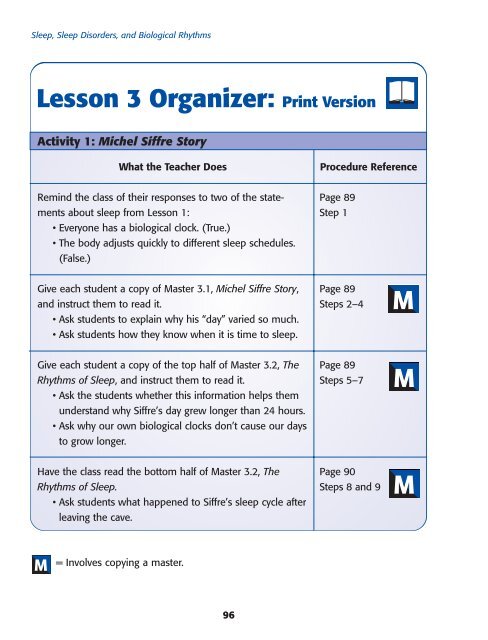Biological - NIH Office of Science Education - National Institutes of ...
Biological - NIH Office of Science Education - National Institutes of ...
Biological - NIH Office of Science Education - National Institutes of ...
Create successful ePaper yourself
Turn your PDF publications into a flip-book with our unique Google optimized e-Paper software.
Sleep, Sleep Disorders, and <strong>Biological</strong> Rhythms<br />
Lesson 3 Organizer: Print Version<br />
Activity 1: Michel Siffre Story<br />
What the Teacher Does<br />
Procedure Reference<br />
Remind the class <strong>of</strong> their responses to two <strong>of</strong> the statements<br />
about sleep from Lesson 1:<br />
• Everyone has a biological clock. (True.)<br />
• The body adjusts quickly to different sleep schedules.<br />
(False.)<br />
Page 89<br />
Step 1<br />
Give each student a copy <strong>of</strong> Master 3.1, Michel Siffre Story,<br />
and instruct them to read it.<br />
• Ask students to explain why his “day” varied so much.<br />
• Ask students how they know when it is time to sleep.<br />
Page 89<br />
Steps 2–4<br />
Give each student a copy <strong>of</strong> the top half <strong>of</strong> Master 3.2, The<br />
Rhythms <strong>of</strong> Sleep, and instruct them to read it.<br />
• Ask the students whether this information helps them<br />
understand why Siffre’s day grew longer than 24 hours.<br />
• Ask why our own biological clocks don’t cause our days<br />
to grow longer.<br />
Page 89<br />
Steps 5–7<br />
Have the class read the bottom half <strong>of</strong> Master 3.2, The<br />
Rhythms <strong>of</strong> Sleep.<br />
• Ask students what happened to Siffre’s sleep cycle after<br />
leaving the cave.<br />
Page 90<br />
Steps 8 and 9<br />
= Involves copying a master.<br />
96

















